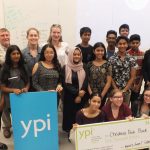By John Myers
This project began when during the November 2016 practicum, as TCs (Teacher Candidates) were in schools, the Ontario Ministry came out with its new resource guides First Nations, Métis, and Inuit Connections: Scope and Sequence of Expectations. One document was for grade 9-12 and 1 for grade 1-8.
When practicum was over I proposed to the 10 members of my Masters of Teaching Intermediate History “subject specialist” class to reshape their major second term assignment to work on a package for teachers. As I would model ideas to incorporate these curriculum expectations into the grade 8 course, they would adapt or create their own incorporations in the two units in grade 7 history.
In our first class in December and our first class in January we shaped the parameters of the project and I did some modeling. Then while we worked through this and other aspects of teaching history the class had three classes over three weeks to work on their projects. They handed in their work early in February and we did some minor edits before I graded their work.
What We Did
As a class we discussed what an indigenous lens on history curriculum might look like and decided on the following as first steps:
- recognition of the relationship between the land of Canada / North America / the Americas in general and the original human inhabitants
- identifying characteristics of an indigenous “world view” including spirituality
- identifying and comparing indigenous and European settler concepts of land, government, etc.
- noting the effects of European settlement on indigenous populations in areas such as conflict and war, co-operation and treaty-making, economics, technology, impacts on the environment, medicine and disease
There would need to be an introduction to the project including:
- clear rationale for teachers to elaborate on what the ministry has said
- a review on what “should have been done in previous grades and subjects” to serve as a review or assessment of prior learning or bringing students “up to speed”
- an introductory lesson of the vocabulary we use officially, legally, and preferred by the indigenous communities themselves: this lesson could introduce any study of indigenous populations
Working within units and lessons in the grade 7-8 courses would be based on the history curriculum expectations but integrated where suitable to other subjects such as geography, science, art, music, and English language arts. In addition to the “review” and “vocabulary” lessons we designed four lessons for each of the strands in the grade seven course in Ontario. This curriculum examines topics in Canadian history from 1713-1850. Through OISE’s cohort structure the class subdivided so that TCs could collaborate online as well as face-to-face.
There was an accompanying assignment in which TCs would read a book of their choice (fiction or non-fiction) that connected to the Ontario history curriculum and assess how their book might help them take a new look at history in general, a particular course, unit and/or lesson. Those who selected books looking at aspects of indigenous history, identity or culture were influenced in their work. These book reviews are currently being published on this blog.
What We Did Not Do
These lessons are not the final word on the grade 7 course. We had limited opportunities for quality professional learning in the form of workshops, conferences, or guest speakers, as well as tight time constraints. The constraints we had may be closer to the constraints faced by busy teachers who may not have access to quality professional learning other than their own professional desire to learn and “do the right thing” when it comes to incorporating an indigenous lens into curriculum. After all we had a month in a very busy schedule involving assignments in other courses to do this work. This replicates teachers’ work trying to meet many demands in their classes and school communities, some of which may not be complementary.
If this project were continued I see tackling the grade 8 program to develop units and lessons based on:
- western expansion of European Canadians and their environmental, economic, social, and health-related effects on the indigenous populations
- Louis Riel
- the Indian Act and the treaty system
- residential schools
- connections to and with other non-European immigrants
- apt comparisons with the American scene (since that is often what Canadians know due to media)
There has been work done at the grade 10 level (which Nancy Hamer Strahl and Flora Fung have been involved in and which was presented at an OHASSTA conference). Time constraints prevented us from effectively learning from this work.
We did discuss potential unit and/or course culminating tasks but time constraints prevented us from designing them. Our discussions conclude our unit and lesson work.
Our goal is to create a package for teachers to help them in their efforts to work with their students since teachers may need more knowledge and sensitivity in order to feel comfortable.
In discussing equity curricula with a consultant in the York Region District School Board we recognized that the above challenges are present in working to include all groups conventionally marginalized or even omitted from official curricula. I shared with that consultant our mutual understanding of the James Banks multicultural integration levels (Banks, 1993) and how we might go beyond the “Additive Level”.
After looking at the TRC’s Calls to Action dealing with education some 40 TCs (from the classes NOT involved in this project) made more than 100 comments when we asked for OISE to move forward.
The list represents common ideas held by a number of TCs which I summarized or combined. Some of these I know are already being considered and even acted upon. I offer some of my thoughts in brackets.
- promoting integration and avoiding tokenism (we use James Banks ( cit.) continuum of inclusion in my classes, among other work, as a starting point and considered related work (McIntosh, 2000))
- promoting some classroom / action research on the above in MTRPs (Masters of Teaching Research Papers)
- ensuring approaches in integrating the above connections in all subjects
- avoiding cultural appropriations
- inviting indigenous speakers to classrooms
- avoiding generalizations and stereotyping and recognizing diversity in all communities, indigenous and non-indigenous
- promoting place-based learning
- looking at issues such as land and environment
- inclusion should be “genuine” not forced
- accurate language and vocabulary
- a distinct course at OISE
- techniques for dealing with pushback from students, teachers, or people from the larger community
- considering all marginalized groups in society
- networking with indigenous communities with the possibility of doing a practicum at a First Nations or Inuit school
- courses (perhaps in AQ or graduate level) in aboriginal languages since many teachers who teach in northern communities have little understanding of the local language
- incorporation of appropriate indigenous teaching practices such as the use of a medicine wheel as a course opener (we have done sharing circles in my class- initiated by my TCs.)
Among the questions TCs asked were:
- What are the implications of being taught about indigenous history, identity and culture by non-indigenous teachers? Who has “authority” to teach these issues?
- How important are these issues?
- What parts of our curricula are the best places to introduce relevant issues?
- How should such teaching be taught in classrooms with a) a number of self-identified indigenous students? b) classes with indigenous students who do not self-identify? c) classes with no indigenous students? (This was a discussion when I taught about some of the relevant issues in the 1970s in my high school and later in a faculty of education class at University of British Columbia.)
My key question for readers is to ascertain to what extent do these lessons if done effectively move beyond James Banks’ “Additive Level” of integration?
References:
Banks, J. (1993). Approaches to multicultural curriculum reform. In J. Banks and C. Banks (Eds.), Multicultural education: Issues and perspectives. Boston: Allyn & Bacon.
McIntosh, P. (2000). Interactive phases of personal and curricular re-vision with regard to race. In G. Shin and P. Gorski (Eds.), Multicultural resource series: Professional development for educators. Washington, D.C.: National Education Association.
Postscript:
The assessments considered in the project, but not fully developed, look at use of a Visible Thinking routine / protocol (based on work from Harvard’s graduate school of education’s Visible Thinking project http://www.pz.harvard.edu/projects/visible-thinking) to demonstrate the impact of the study on student understanding and conception of the issues raised.

